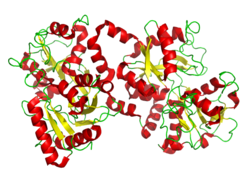- Lactoferrin
-
Lactoferrin Bändermodell nach PDB 1B0L Masse/Länge Primärstruktur 691 Aminosäuren Bezeichner Gen-Name LTF Externe IDs OMIM: 150210 UniProt: P02788 Enzymklassifikation EC, Kategorie 3.4.21.- Serinproteinase MEROPS S60.001 Reaktionsart Spaltung einer Peptidbindung Substrat X-Arg-Ser-Arg-Arg-*-Y oder X-Arg-Arg-Ser-Arg-*-Y Produkte Y + X-Arg-Ser-Arg-Arg oder X-Arg-Arg-Ser-Arg Vorkommen Homologie-Familie Transferrin Übergeordnetes Taxon Euteleostomi Lactoferrin (genauer: Lactotransferrin) ist ein Protein, das in den Sekretionen aller Säugetiere, insbesondere in deren Milch, zu finden ist, und einerseits als Protease, andererseits als eisen-bindendes Protein fungiert. Außerdem ist es in weißen Blutkörperchen lokalisiert.[1][2]
Als Protease ist Lactoferrin in der Lage, mehrere für die Besiedlung wichtige Proteine des Krankheitserregers Haemophilus influenzae zu zerstören. Insbesondere die in der menschlichen Muttermilch vorkommende Konzentration an Lactoferrin kann die bei Kleinkindern oft auftretenden Atemwegsinfektionen mit diesem Keim verhindern. Außerdem beeinträchtigt es in Shigella und pathogenen Escherichia coli das Typ III-Sekretionssystem. Von Leukozyten freigesetzt, ist es so auch Teil des Immunsystems.[3][4][5][6]
Infektionen mit HTLV-1 werden durch Lactoferrin beschleunigt. Auf der anderen Seite kann das Protein die Replikation des HIV-1 verhindern.[7]
Wie eine aktuelle Studie des Journal of the American Medical Association zeigt, kann die Gabe von Lactoferrin an Neugeborene mit Untergewicht (< 1500 g Geburtsgewicht) das Auftreten einer Sepsis sowie die Sepsis-assoziierte Mortalität signifikant und klinisch relevant senken.[8]
Literatur
- Ward PP, Paz E, Conneely OM: Multifunctional roles of lactoferrin: a critical overview. In: Cell. Mol. Life Sci.. 62, Nr. 22, November 2005, S. 2540–8. doi:10.1007/s00018-005-5369-8. PMID 16261256.
- Lönnerdal B: Nutritional roles of lactoferrin. In: Curr Opin Clin Nutr Metab Care. 12, Nr. 3, Mai 2009, S. 293–7. doi:10.1097/MCO.0b013e328328d13e. PMID 19318940.
Einzelnachweise
- ↑ Legrand D, Pierce A, Elass E, Carpentier M, Mariller C, Mazurier J: Lactoferrin structure and functions. In: Adv. Exp. Med. Biol.. 606, 2008, S. 163–94. PMID 18183929.
- ↑ Anderson BF, Baker HM, Dodson EJ, et al: Structure of human lactoferrin at 3.2-A resolution. In: Proc. Natl. Acad. Sci. U.S.A.. 84, Nr. 7, April 1987, S. 1769–73. PMID 3470756. Volltext bei PMC: 304522.
- ↑ Plaut AG, Qiu J, St Geme JW: Human lactoferrin proteolytic activity: analysis of the cleaved region in the IgA protease of Haemophilus influenzae. In: Vaccine. 19 Suppl 1, Dezember 2000, S. S148–52. PMID 11163480.
- ↑ Qiu J, Hendrixson DR, Baker EN, Murphy TF, St Geme JW, Plaut AG: Human milk lactoferrin inactivates two putative colonization factors expressed by Haemophilus influenzae. In: Proc. Natl. Acad. Sci. U.S.A.. 95, Nr. 21, Oktober 1998, S. 12641–6. PMID 9770539. Volltext bei PMC: 22884.
- ↑ Hendrixson DR, Qiu J, Shewry SC, et al: Human milk lactoferrin is a serine protease that cleaves Haemophilus surface proteins at arginine-rich sites. In: Mol. Microbiol.. 47, Nr. 3, Februar 2003, S. 607–17. PMID 12535064.
- ↑ Ochoa TJ, Clearly TG: Lactoferrin disruption of bacterial type III secretion systems. In: Biometals. 17, Nr. 3, Juni 2004, S. 257–60. PMID 15222474.
- ↑ Moriuchi M, Moriuchi H: A milk protein lactoferrin enhances human T cell leukemia virus type I and suppresses HIV-1 infection. In: J. Immunol.. 166, Nr. 6, März 2001, S. 4231–6. PMID 11238676.
- ↑ Manzoni P, Rinaldi M, Cattani S, et al.: Bovine lactoferrin supplementation for prevention of late-onset sepsis in very low-birth-weight neonates: a randomized trial. In: JAMA. 302, Nr. 13, Oktober 2009, S. 1421–1428. doi:10.1001/jama.2009.1403. PMID 19809023. Abgerufen am 17. Oktober 2009.
Wikimedia Foundation.

